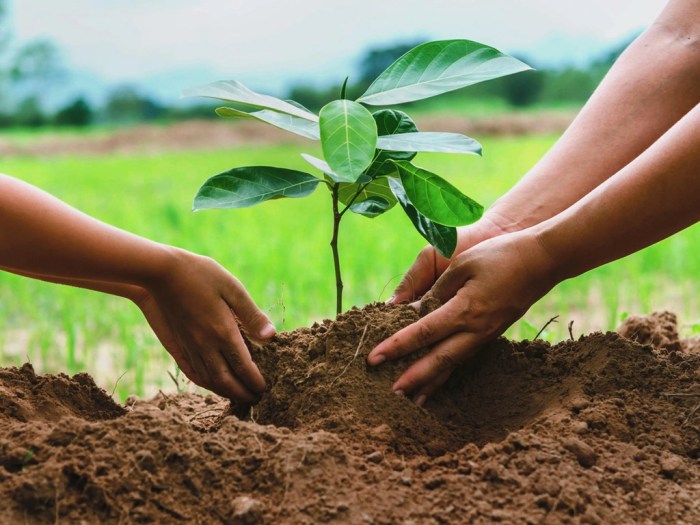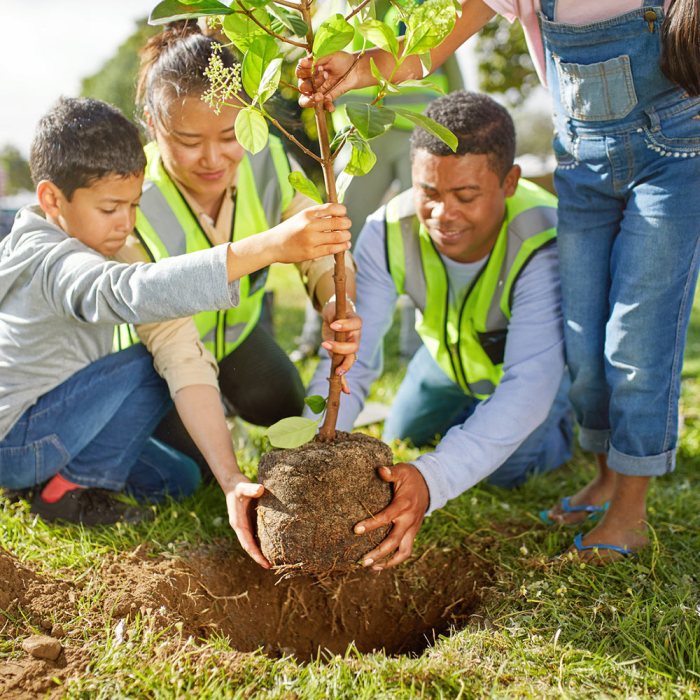Suitable Locations for Tree Planting

Where can i plant trees – So, you’ve decided to become a tree-planting superhero? Fantastic! But before you go flinging saplings willy-nilly, let’s talk strategy. Choosing the right spot is crucial – it’s the difference between a thriving forest and a sad, wilting sapling that looks like it lost a fight with a squirrel. Think of it as real estate for trees, but with way less paperwork.Planting a tree is like choosing a vacation home for a very long-term tenant – it needs the right climate, amenities (sun, water), and a solid foundation (soil).
Get it wrong, and you’ll be dealing with a cranky tree for decades.
Soil Type, Sunlight, Water, and Tree Species Compatibility, Where can i plant trees
The success of your tree-planting mission hinges on understanding the needs of your arboreal friends. Different trees have different preferences, much like picky eaters at a buffet. Some prefer sun-drenched locations, others crave the shade, and soil type is just as important as the neighborhood. Let’s break it down:
| Soil Type | Sunlight Requirements | Water Needs | Suitable Tree Species |
|---|---|---|---|
| Well-drained sandy loam | Full sun (6+ hours) | Moderate | Oak, Pine, Birch |
| Clay soil (with good drainage amendments) | Partial shade (4-6 hours) | Moderate to high (depending on drainage) | Maple, Dogwood, Willow (certain varieties) |
| Rich, moist soil | Partial shade to full shade | High | Redwood, Spruce (some varieties), Alder |
| Rocky, dry soil | Full sun | Low | Juniper, Acacia, certain drought-tolerant pines |
Remember, these are just general guidelines. Always check the specific needs of the tree species you’re planting. Think of it as consulting a tree’s dating profile before committing to a long-term relationship.
Considering where to plant trees, the choice depends greatly on the species and the soil conditions. For instance, if you’re wondering about a specific type of tree, the question arises: can i plant my christmas tree ? This depends on the species and your local climate. Ultimately, successful tree planting requires careful consideration of these factors to ensure healthy growth, wherever you choose to plant.
Microclimates and Their Impact on Tree Growth
Now, here’s where things get interesting (and slightly more complicated, but hey, we’re aiming for superhero status, right?). Microclimates are like tiny pockets of different weather within a larger area. A south-facing slope, for example, will be warmer and drier than a north-facing one. A sheltered valley might be more protected from wind. These subtle differences can drastically affect a tree’s growth and survival.Imagine a sunny, south-facing slope versus a shady, north-facing one.
The sunny slope might be perfect for a sun-loving oak, while the shady spot might be ideal for a shade-tolerant maple. Ignoring these microclimates is like ignoring the fact that your neighbor’s dog has a penchant for chewing on shoes – you’re asking for trouble. Consider factors like wind exposure, proximity to buildings (which can create heat islands), and even the presence of large bodies of water, which can moderate temperatures.Choosing the right tree for the right microclimate is like finding the perfect puzzle piece – it fits perfectly and makes the whole picture much more beautiful.
Post-Planting Care and Maintenance

So, you’ve bravely planted your little tree sapling. Congratulations! Now comes the slightly less glamorous, but equally important, part: keeping it alive. Think of it as tree-parenting – a surprisingly demanding, yet ultimately rewarding, experience. We’re not talking about fairy godmothers here; this requires elbow grease and a healthy dose of patience.Watering, fertilizing, and mulching are your new best friends.
These seemingly simple acts are the foundation of a thriving tree, and neglecting them is like forgetting to feed your pet unicorn (which, let’s be honest, would be a tragedy of epic proportions).
Watering Schedule for Newly Planted Trees
Proper watering is crucial, especially during the first year. Overwatering can lead to root rot, while underwatering, well, leads to a very unhappy (and possibly deceased) tree. Aim for deep, infrequent watering rather than shallow, frequent watering. This encourages deep root growth, making your tree more resilient to drought later on. A good rule of thumb is to water deeply once a week during dry periods, adjusting based on weather conditions and soil type.
Feel the soil; if it’s dry a few inches down, it’s time to water. Think of it like checking your own hydration levels – if you’re parched, your tree probably is too.
Fertilizing Young Trees
Fertilizing helps your tree grow strong and healthy. However, too much fertilizer can be just as harmful as too little. Use a slow-release fertilizer specifically formulated for trees, following the package instructions carefully. Over-fertilizing can burn the roots, leading to stunted growth or even death. Imagine giving your pet unicorn a whole bucket of sugary treats – not a good idea! A balanced fertilizer, applied once or twice a year during the growing season (spring and early summer), is usually sufficient.
Mulching Around Young Trees
Mulching is like giving your tree a cozy blanket. It helps retain soil moisture, suppresses weeds (those pesky tree bullies!), and regulates soil temperature. Use a 2-3 inch layer of organic mulch, such as wood chips or shredded bark, keeping it a few inches away from the tree trunk to prevent rot. Think of it as a stylish, protective layer that keeps your tree happy and comfortable.
Common Post-Planting Problems and Solutions
Let’s face it; tree-planting isn’t always a walk in the park. Pests, diseases, and drought stress can all wreak havoc on your precious sapling. Early detection and appropriate action are key. For example, if you notice signs of pests like aphids or scale insects, a gentle spray of insecticidal soap can often do the trick. For diseases, consult a local arborist or nursery professional for diagnosis and treatment options.
They are the tree doctors, and they know their stuff. Drought stress can be mitigated by proper watering techniques, as mentioned earlier.
Pruning and Supporting Young Trees
Pruning helps shape your tree and remove dead or damaged branches. Proper pruning techniques are essential to ensure healthy growth. Avoid heavy pruning, especially in the first few years. Remove only dead, damaged, or crossing branches. Support young trees, especially those planted in windy areas, with stakes or tree guards to prevent them from being damaged by wind or animals.
Imagine training a young gymnast – gentle guidance and support are key to proper development.
Environmental Impact and Benefits of Tree Planting: Where Can I Plant Trees

So, you’ve planted a tree. Congratulations, you magnificent arboreal architect! But beyond the sheer satisfaction of sticking a twig in the ground and watching it grow (slightly less exciting than it sounds, admittedly), what’s the big deal? Why should anyone care about your newfound green thumb? Well, let’s delve into the surprisingly dramatic environmental impact of tree planting – it’s less “planting a tree” and more “single-handedly saving the planet” (okay, maybe not single-handedly, but you get the idea).Trees are like nature’s superheroes, silently battling climate change, cleaning the air, and providing homes for a whole host of creatures.
They’re the unsung heroes of the environmental world, and we need to give them some serious props. Seriously, trees deserve more awards. Maybe a Nobel Prize for environmental excellence? I’m just saying.
Carbon Sequestration: Trees as Carbon-Sucking Machines
Trees are natural carbon sinks, meaning they absorb carbon dioxide (CO2) from the atmosphere during photosynthesis. This process is essentially trees converting CO2, a major greenhouse gas contributing to climate change, into the oxygen we breathe and the wood that makes up their structure. Think of them as tiny, leafy vacuum cleaners, diligently sucking up harmful CO2 and replacing it with life-giving oxygen.
A mature tree can absorb up to 48 pounds of CO2 per year – that’s like having a tiny, environmentally friendly butler diligently cleaning your carbon footprint. The more trees we plant, the more CO2 we can remove from the atmosphere, helping to mitigate the effects of climate change. Planting trees is like giving Mother Nature a high-five, a hug, and a really big carbon-absorbing machine.
Air Purification: Trees as Nature’s Air Filters
Beyond carbon sequestration, trees also filter out other pollutants from the air, improving air quality in urban and rural areas. They act as natural air filters, trapping dust, pollen, and other harmful particles on their leaves and bark. This is especially beneficial in cities where air pollution can be a significant health concern. Imagine a city where the air is fresh and clean, thanks to the tireless work of millions of trees.
It’s like a giant, natural air purifier, making our cities healthier and more pleasant places to live. Think of it as a giant, green, leafy air freshener for the planet.
Habitat Creation: Trees as Wildlife Apartments
Trees provide vital habitats for a wide range of plants and animals. From birds nesting in their branches to insects finding shelter in their bark, trees support biodiversity and create thriving ecosystems. A single tree can be home to hundreds of different species, making them crucial for maintaining the balance of nature. Planting trees is like building tiny, leafy apartments for all sorts of creatures, creating a bustling, biodiverse community.
It’s a win-win: trees get a home, and wildlife gets a place to live.
Comparing Environmental Impact of Different Tree Species
The environmental impact of planting different tree species varies significantly. Fast-growing trees like willows and poplars absorb CO2 quickly, but they may have shorter lifespans. Slower-growing trees like oaks and maples live longer and store more carbon over their lifetime. Consider the local climate, soil conditions, and desired outcomes when choosing tree species. Choosing the right tree for the right place is crucial for maximizing the environmental benefits.
It’s like choosing the right tool for the job; you wouldn’t use a hammer to screw in a screw, and you shouldn’t plant a tree that won’t thrive in its environment.
Long-Term Benefits of Community Tree Planting Initiatives
Community tree planting initiatives offer numerous long-term benefits, fostering a sense of community, improving local environments, and increasing property values. These initiatives demonstrate the power of collective action in tackling environmental challenges. Imagine a community transformed by the collective effort of planting trees – cleaner air, more beautiful landscapes, and a stronger sense of community pride. It’s like a community-wide hug for the planet, a testament to the power of collective action and environmental stewardship.
It’s more than just planting trees; it’s building a greener, healthier, and more connected community.
FAQ Summary
Can I plant a tree on the beach?
Generally, no. Coastal areas often have strict regulations to protect fragile ecosystems. Check with local authorities before planting anything near the beach.
What if my tree dies?
Don’t stress! Sometimes trees don’t make it, despite your best efforts. Consider factors like soil conditions, pests, or improper planting. Learn from the experience and try again!
Where can I find free saplings?
Many local community groups and environmental organizations offer free or discounted saplings. Check online or contact your local council.
How often should I water a newly planted tree?
Regular watering, especially during dry periods, is key. Aim for deep, infrequent watering rather than shallow, frequent watering. The frequency depends on the climate and tree species.
